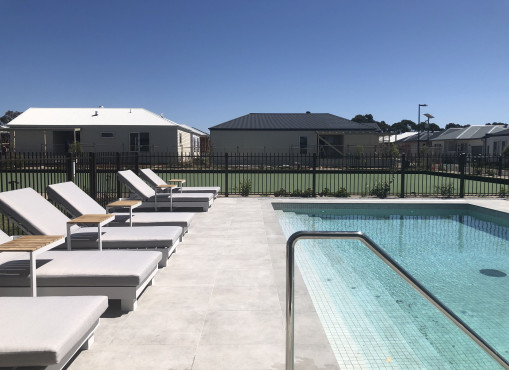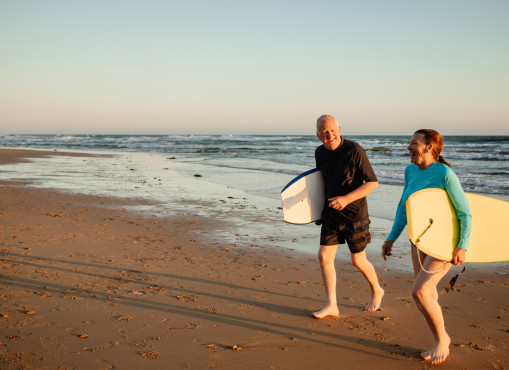- Home
- /
- All blog articles
- /
- Top tennis tips for beginners

This is the life
5 minute read
Top tennis tips for beginners
Learning a new sport can be very enjoyable. In particular, tennis is a wonderful sport for all ages. Gain an advantage by considering these top five tips, presented by an expert tennis coach and player with 50 years' of experience. Read on to get match ready with these quick tennis tips, perfect for beginners. Let’s get started.
Tip #1 Knowing your grip
There are three grips available in tennis. Consider each and then make your option based on what feels natural. It’s important to remember that you’re born with your own unique technique and we’re just trying to develop it. Your technique is your life, it is your style and that is what we’ll use as a base to try and develop.
Continental Grip-slightly open face. Hold the tennis racket so the strings and rim are on edge. Then, shake hands with your racket. This is the classic approach coaches have been using since day one. If you roll your hand right across the top of the grip, you’ll notice that the face of your racket is slightly open. For the forehand side, the racket slants open. This is called the Continental Grip. Very few players are born with a natural Continental Grip—merely one or two percent.
Eastern Grip-slightly closed face. This is the most common grip and the one that is natural for most beginners. The Eastern Grip involves barely rotating your hand compared to the Continental, closing the face on your tennis racket slightly.
Western Grip-highly closed face. This grip is the one we’re seeing the most of these days. It is also the preferred grip that kids tend to want to coach. Based out of Europe, the Western Grip was developed off the clay courts. For this grip, take the racket from behind, causing a highly closed face.
To recap, there are three grips in tennis: the Continental, the Eastern on top, and the Western behind. You can tell a lot by a person’s grip choice. The minute you grab the racket, that tells me exactly how you play your tennis.
Tip #2 The right equipment
Choosing a racket grip. There was a time when tennis players had the choice of three grips: the 3/8, the half inch and the 5/8, each pertaining to the girth of the racket handle. They no longer make the 5/8, because they now put grip tape around the racket handle to increase it up to roughly a 5/8 and then squash us back down to a comfortable four and a half. Choosing the right grip size is incredibly important because everybody who plays with an undersized racket ends up with tennis elbow. Therefore, the choice of your equipment is paramount.
Choosing a racket size. There are two things to look for in your selection. When choosing a racket, go for a little bit heavier than you’d like and a little bit larger than you’d like. It might feel strange at first but you will quickly get used to it. Choosing a racket that is larger and heavier will diminish the opportunity for tennis elbow to occur. This can be a game changer because once you’ve got tennis elbow, it can be difficult to maintain your level of gameplay. This injury can take a long time to heal. For someone who is doing tennis coaching and/or hitting a lot of tennis balls, you should be using something just a little heavier than you’d like and a little larger than you’d like, in order to protect your elbow.
Choosing your shoes. Footwear is usually a personal choice. However, two key factors can improve your game: instep support and traction. Choose something that supports your instep and gives you good traction. For example, Dunlop Volleys are a sure choice, because they do not slip and they don’t give up.
Tip #3 Perfecting your swing
A great tennis tip for beginners to strengthen their swing is to remember this three part motto: Step, Rotate and Follow. Start in ready position on the baseline. Check that your grip is set. Next, step forward and across about two feet with your left foot. Now, we’ll emphasise the backswing. Throw that racket back by just lifting it up and over in a looping motion. Make sure to rotate your body to take the strain off your arm and employ the strength in your shoulder because that’s where your power is. Once you’ve executed the loop, follow through and hit with that shoulder, reaching right out into the shot.
Tip #4 Practice your footwork
Every great tennis player needs to establish their footwork, understand how it applies to their stroke and how to address the ball. A great tip for beginners is to practice moving along the baseline from forehand to backhand. As you go along the baseline, cut it like a V, moving diagonal for a backhand, then re-centering at the baseline before moving diagonal on the opposite side for a forehand. This technique is a great start to develop fantastic footwork.
Tip #5 Three point attack
Having a solid attack strategy is essential for a solid game plan. Use the three point attack—Approach Shot, 1st Volley Shot and 2nd Volley Shot—to win the point. First, start with an approach shot off the baseline. After you make your shot, come up to the net. You know you’re attacking the net so you should dig deep down the court by hitting straight ahead. Come to the first volley position, which is quite commonly around the T, near the service line and centre mark. Take that second shot, which is the most important for this sequence. Put the second shot down the middle on the baseline. Then, you’re in position for the kill. Come up for the second volley. Because of the depth of your first volley, the opponent usually throws something up that’s a little bit subdued. Strike this opportunity by just banging the ball into the open court. Remember, there’s a one, two, three procedure on taking the net.
Tennis is a technique sport that anyone can learn if they have the correct strategy. Knowing your grip, using the right equipment, perfecting your swing, practicing your footwork and using the three point attack are essential elements that all players, beginners and experts alike, must keep in mind. Take advantage of these five top tennis tips to improve your game!
Tip #1 Knowing your grip
There are three grips available in tennis. Consider each and then make your option based on what feels natural. It’s important to remember that you’re born with your own unique technique and we’re just trying to develop it. Your technique is your life, it is your style and that is what we’ll use as a base to try and develop.
Continental Grip-slightly open face. Hold the tennis racket so the strings and rim are on edge. Then, shake hands with your racket. This is the classic approach coaches have been using since day one. If you roll your hand right across the top of the grip, you’ll notice that the face of your racket is slightly open. For the forehand side, the racket slants open. This is called the Continental Grip. Very few players are born with a natural Continental Grip—merely one or two percent.
Eastern Grip-slightly closed face. This is the most common grip and the one that is natural for most beginners. The Eastern Grip involves barely rotating your hand compared to the Continental, closing the face on your tennis racket slightly.
Western Grip-highly closed face. This grip is the one we’re seeing the most of these days. It is also the preferred grip that kids tend to want to coach. Based out of Europe, the Western Grip was developed off the clay courts. For this grip, take the racket from behind, causing a highly closed face.
To recap, there are three grips in tennis: the Continental, the Eastern on top, and the Western behind. You can tell a lot by a person’s grip choice. The minute you grab the racket, that tells me exactly how you play your tennis.
Tip #2 The right equipment
Choosing a racket grip. There was a time when tennis players had the choice of three grips: the 3/8, the half inch and the 5/8, each pertaining to the girth of the racket handle. They no longer make the 5/8, because they now put grip tape around the racket handle to increase it up to roughly a 5/8 and then squash us back down to a comfortable four and a half. Choosing the right grip size is incredibly important because everybody who plays with an undersized racket ends up with tennis elbow. Therefore, the choice of your equipment is paramount.
Choosing a racket size. There are two things to look for in your selection. When choosing a racket, go for a little bit heavier than you’d like and a little bit larger than you’d like. It might feel strange at first but you will quickly get used to it. Choosing a racket that is larger and heavier will diminish the opportunity for tennis elbow to occur. This can be a game changer because once you’ve got tennis elbow, it can be difficult to maintain your level of gameplay. This injury can take a long time to heal. For someone who is doing tennis coaching and/or hitting a lot of tennis balls, you should be using something just a little heavier than you’d like and a little larger than you’d like, in order to protect your elbow.
Choosing your shoes. Footwear is usually a personal choice. However, two key factors can improve your game: instep support and traction. Choose something that supports your instep and gives you good traction. For example, Dunlop Volleys are a sure choice, because they do not slip and they don’t give up.
Tip #3 Perfecting your swing
A great tennis tip for beginners to strengthen their swing is to remember this three part motto: Step, Rotate and Follow. Start in ready position on the baseline. Check that your grip is set. Next, step forward and across about two feet with your left foot. Now, we’ll emphasise the backswing. Throw that racket back by just lifting it up and over in a looping motion. Make sure to rotate your body to take the strain off your arm and employ the strength in your shoulder because that’s where your power is. Once you’ve executed the loop, follow through and hit with that shoulder, reaching right out into the shot.
Tip #4 Practice your footwork
Every great tennis player needs to establish their footwork, understand how it applies to their stroke and how to address the ball. A great tip for beginners is to practice moving along the baseline from forehand to backhand. As you go along the baseline, cut it like a V, moving diagonal for a backhand, then re-centering at the baseline before moving diagonal on the opposite side for a forehand. This technique is a great start to develop fantastic footwork.
Tip #5 Three point attack
Having a solid attack strategy is essential for a solid game plan. Use the three point attack—Approach Shot, 1st Volley Shot and 2nd Volley Shot—to win the point. First, start with an approach shot off the baseline. After you make your shot, come up to the net. You know you’re attacking the net so you should dig deep down the court by hitting straight ahead. Come to the first volley position, which is quite commonly around the T, near the service line and centre mark. Take that second shot, which is the most important for this sequence. Put the second shot down the middle on the baseline. Then, you’re in position for the kill. Come up for the second volley. Because of the depth of your first volley, the opponent usually throws something up that’s a little bit subdued. Strike this opportunity by just banging the ball into the open court. Remember, there’s a one, two, three procedure on taking the net.
Tennis is a technique sport that anyone can learn if they have the correct strategy. Knowing your grip, using the right equipment, perfecting your swing, practicing your footwork and using the three point attack are essential elements that all players, beginners and experts alike, must keep in mind. Take advantage of these five top tennis tips to improve your game!


